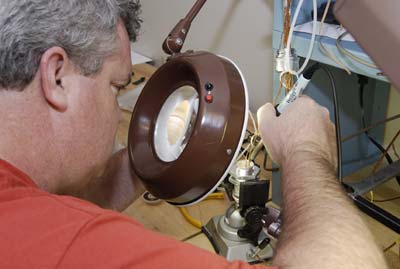In the meantime, NASA set a new date for the launch of the Atlantis shuttle - January 24, and asked the teams handling the sensor failure to gather on this date

NASA planned to carry out six launches this year - double the number of flights in each of the last two years - but this plan has already become complex due to the grounding of the shuttle Atlantis as a result of a repeated electrical failure.
The NASA website stated that the flight controllers and ground crews handling the Atlantis shuttle were asked to do everything so that the shuttle could take off on January 24, two and a half months late compared to the original date for the STS-122 mission, during which it would bring up the European Columbus Laboratory that would connect to the station and allow for its expansion. This date is also not yet final and may change depending on the progress of the works. The launch date depends, among other things, on the results of tests and adjustments made to the fuel sensor system in the external fuel tank. If it becomes necessary to postpone, NASA operates a launch window that will open on January 24 and end in the first week of February.
The sensors are suspected of showing false readings during the shuttle's two previous launch attempts, which were aborted due to this malfunction. NASA engineers also looked into making changes to sensors and the fuel connector between the tank and the shuttle's engines to ensure the shuttle's flightworthiness.
Although NASA began implementing strict safety procedures as a result of the Columbia disaster, the tight schedule led to fears that an agency subject to budgetary and political pressures could once again find itself playing the fate of the shuttles, whose maintenance requirements are among the highest known in the aviation world.
NASA officials are still confident that the three remaining shuttles will be able to complete the 13 flights remaining to assemble the space station by the end of the project in September 2010. Bill Gerstenmeyer, who has worked on the shuttle program since its inception and is now the director of NASA's Manned Space Operations, says that flying the shuttles has proven time and time again how difficult it is. send humans into space. However, despite their age, the shuttles are now safe due to the lessons that NASA has learned, they are also in good condition, and will be able to fly after 2010 if necessary, but the only problem is the financial and logistical limitations needed to replace the fleet with new generation spacecraft (Orion), which can To take off to the moon and Mars as well and not be satisfied with a low orbit around the earth.
In an interview with the Washington Post, a member of the investigative committee for the Columbia disaster, Prof. John Logsdon from George Washington University, said that it is NASA's duty to prevent at all costs another disaster that could cause the cessation of manned flights into space for many years, "Every time we launch a shuttle we endanger the future of the manned space program, the sooner we stop the flights with these dangerous vehicles, the better for the space program."
NASA did not internalize the Challenger disaster and therefore the Columbia disaster was caused
An overview of the Orion project that will replace the shuttle

4 תגובות
You are allowed to ask, but when a person asks 500 such questions, and demands immediate answers instead of looking for them on Wikipedia, it is already excessive. In this case, this is another reasonable question. Sometimes the questions were such that their answers were in the text.
I'm sorry, but it's hard for me to work, to volunteer on the site, and to take care of people who are bored.
You are allowed to ask
They sent them a carrier pigeon, but it couldn't climb beyond the atmosphere, so they sent a plane and it didn't make it either, so they opened a radio receiver but they ran away after ten minutes, so they used a communication satellite but because you caught the line with trivial questions They couldn't make contact either.
A question for my father, the editor of the site, I read on the NASA website that stunts
They talked to the space station, that is, to the occupants, about how they did it